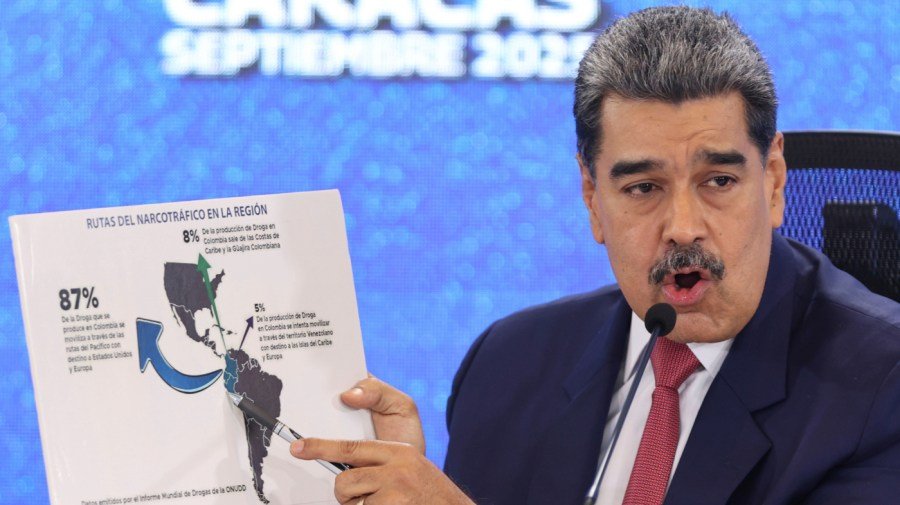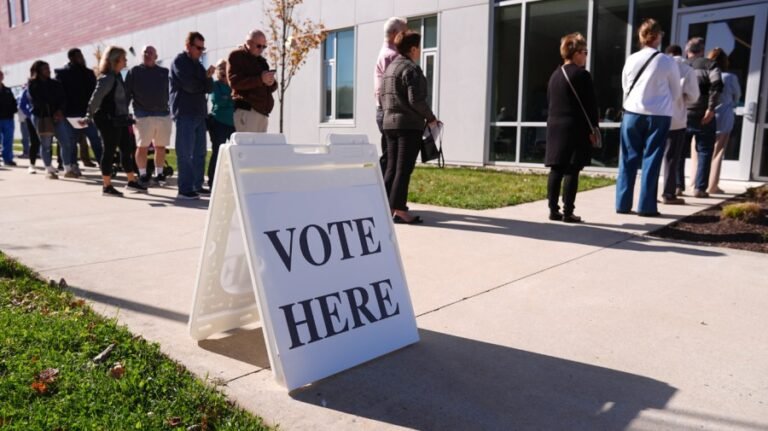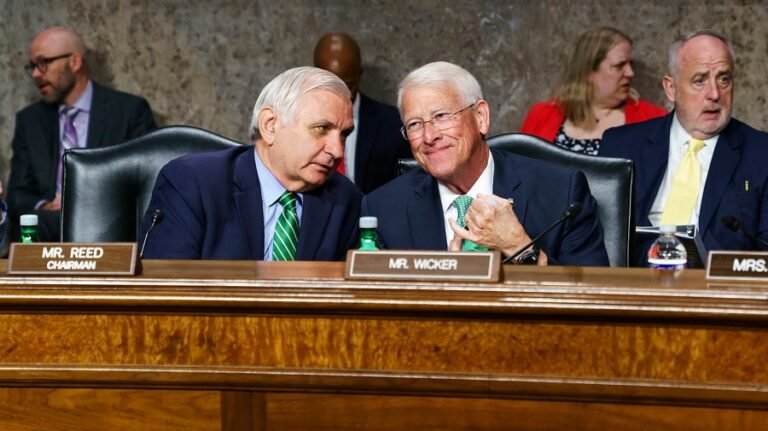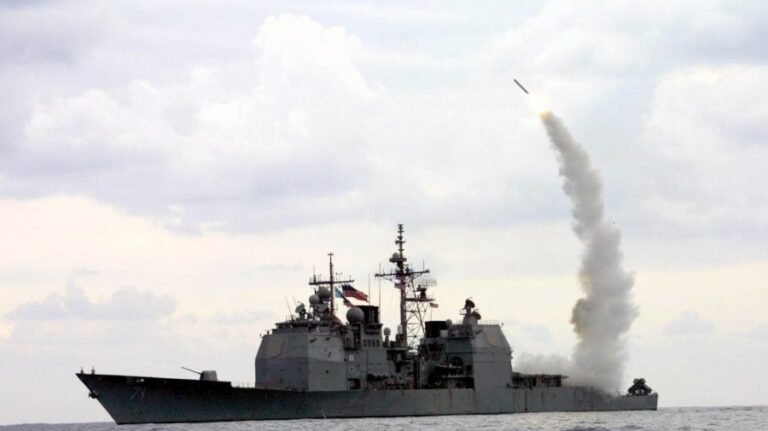
The U.S. launching strikes within Venezuela is looking increasingly likely as the Trump administration continues to bolster the buildup of military assets in the region, turning up the pressure against Venezuelan President Nicolás Maduro, whom U.S. officials have characterized as an “illegitimate leader.”
The administration has identified military facilities in Venezuela used to smuggle narcotics as potential targets for the attack, although President Trump has not made a final decision on whether to carry out strikes inside the South American country, The Wall Street Journal reported Thursday night. Potential targets under consideration are military-controlled airports and ports, including airstrips and naval facilities, the outlet reported, citing one U.S. official.
When asked on Friday if he is considering strikes in Venezuela and if he has made up his mind, Trump denied it.
“No. It’s not true,” the president told reporters aboard Air Force One while en route to Florida.
“We are certainly looking at land now because we’ve got the sea under control,” Trump said at the White House earlier this month when discussing if he was looking at ground strikes in Venezuela.
The administration has taken a more aggressive approach toward the South American country in recent months, blowing up alleged drug-trafficking boats off the coast of Caracas, doubling the Justice Department’s (DOJ) reward for information leading to an arrest of Maduro to $50 million and dispatching military assets in the region, including recently directing the USS Gerald R. Ford, the world’s largest aircraft carrier, and its strike group to the Caribbean.
Mark Cancian, a former Defense Department (DOD) official and senior adviser at the Washington-based Center for Strategic and International Studies (CSIS), said the U.S. is now “much more likely” to conduct strikes.
“First, they’ve been building up assets and activities to do that. They don’t have to do it, but it would be harder to back off unless something happened. I mean, something like, Maduro left, or something like that. But Maduro just stayed there, and the Trump administration did nothing after all this buildup, that would look like a Maduro victory, and he would treat it like that,” Cancian said in an interview with The Hill.
“So they’re going to have to do something, unless Maduro steps down or does something dramatic enough that Trump could claim a success,” he added.
The Miami Herald reported Friday, citing unnamed officials, the potential strikes would aim to ax the hierarchy of the drug cartels in Venezuela. Secretary of State Marco Rubio rebuffed the article, saying it is a “fake story.”
Christopher Hernandez-Roy, a senior fellow and deputy director of the Americas Program at CSIS, noted the denial of reports by Trump, but added that the U.S. military’s role is to “identify strike packages to provide the President with options.”
Hernandez-Roy told The Hill that strikes inside Venezuela would represent a “significant escalation” and they would be “more difficult to explain as simply counter-drug operations, especially if the targets are facilities controlled by the Venezuelan military.”
“If strikes on land occur, I would expect them to be on targets that are more credibly associated with [Drug Trafficking Organizations], say a dock where drug boats are known to depart from, or a warehouse near a dock, or some other infrastructure not connected to the government or the military that is associated with drug trafficking,” he said on Friday.
Defense Secretary Pete Hegseth, when asked Friday while in Malaysia about the military buildup in the Caribbean, said the administration takes the “security of our hemisphere very seriously.”
“I’m obviously not going to talk about the particulars of why troops are where in every circumstance, but they’ve got a clear mission and they’re executing,” he said.
The U.S. has dispatched surveillance planes, fighter jets, warships, at least one submarine and Marines to the region as it continues to take out alleged drug-smuggling boats in the Caribbean and East Pacific, operations that so far have killed at least 61 “narco-terrorists.”
The U.S. currently has the USS Iwo Jima, USS Stockdale, USS Gravely, USS San Antonio, USS Wichita, USS Lake Erie and USS Jason Dunham present in the region, along with the USS Newport News, a nuclear-powered fast-attack submarine, and MV Ocean Trader, a special operations ship that can collect intelligence.
The USS Gettysburg, a Ticonderoga-class guided-missile cruiser, is also now in the Caribbean, a U.S. Navy official, speaking on condition of anonymity, confirmed to The Hill on Friday.
The U.S. does not have enough assets in the region for an invasion, according to Cancian, who said the U.S. military is “well-positioned to do strikes but not to land on Venezuela.”
In light of reports of the U.S. eyeing strikes against Venezuelan targets, Russia, a close ally of Caracas, issued support for Venezuela’s leadership in “defending its national sovereignty, taking into account the dynamics of the international & regional situation.”
“We stand ready to respond appropriately to the requests of our partners in light of emerging threats,” Russia’s foreign ministry said Friday in a statement on social platform X.
Maduro has been asking Iran, China and Russia to bolster its military and for additional assistance, including for jet repairs, defensive radars and potentially missiles, according to documents obtained by The Washington Post.
A Russian aircraft, Ilyushin Il-76, which is sanctioned by the U.S. and has ties to Moscow’s military and Wagner mercenary group, was in Caracas on Sunday after making stops in Armenia, Algeria, Morocco, Senegal and Mauritania, according to flight-tracking data.
Maduro claimed last week that Venezuela has at least 5,000 Russian-made Igla-S man-portable surface-to-air missiles that can engage targets between 1,600 feet and about 3.5 miles and up to 2 miles in altitude, depending on the variant.
Venezuela has anti-ship missiles, including Russian-supplied Kh-31 supersonic missiles that can be fired from Sukhoi Su-30 fighter jets. Caracas also has Iranian anti-ship missiles on its Zulfiqar-class air-defense boats, but Hernandez-Roy said he does not expect either system to penetrate the defensive shields of U.S. ships.
“So those would try to intercept anything that came over Venezuela, whether they’re cruise missiles or aircraft, and they might get lucky if there were actual aircraft that came over Venezuela,” Cancian said. “That’s why I suspect that any air campaign would be done with long-range missiles like Tomahawks. But there are other possibilities too, so you don’t put U.S. service members in danger.”
The American public’s approval of the Navy’s presence around Venezuela has dropped since September, when the first strikes against alleged drug-trafficking boats began taking place, according to a new YouGov survey which was released on Friday. In September, 36 percent at least somewhat approved of the deployment and 38 percent said otherwise. Now, just 30 percent of Americans approve and 37 percent at least somewhat disapprove.
More U.S. adults disapprove than approve of the military’s strikes against alleged drug-smuggling vessels around Venezuela and nearly half of Americans, 47 percent, oppose the military striking land targets in the South American nation, the poll found. Only 19 percent support it.
Progressives, including Sen. Bernie Sanders (I-Vt.) and Rep. Ro Khanna (D-Calif.) voiced their opposition to the potential strikes inside Venezuela, demanding that Trump get Congress’s approval for military action inside the country, while Rep. Maria Elvira Salazar (R-Fla.) proclaimed that Maduro “wanted an early Christmas, but Halloween always comes first.”


